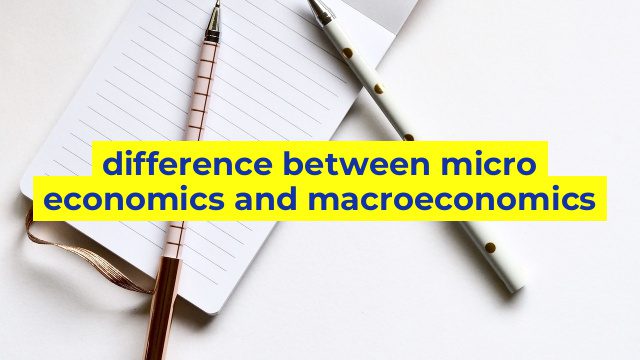Understanding the Difference between Microeconomics and Macroeconomics
When it comes to economics, there are two broad categories that economists typically use to understand the behaviors and activities of individuals, businesses, and entire economies. These two categories are microeconomics and macroeconomics. While both fields of study are critical for understanding the complexities of modern economies, they differ in some fundamental ways. Let’s explore the differences between microeconomics and macroeconomics.
What is Microeconomics?
Microeconomics is the branch of economics that studies the behavior of individuals and firms in making decisions about the allocation of scarce resources. This field of study is concerned with specific market interactions, including price setting and consumer behavior. Microeconomics is interested in the factors that drive supply and demand in individual markets and how people and firms respond to those forces.
Microeconomics involves understanding individual decision-making processes and how those decisions impact the market as a whole. Topics studied in microeconomics include market competition, consumer behavior, production costs, market failures, and the distribution of wealth.
What is Macroeconomics?
Macroeconomics is the branch of economics that studies the performance and structure of entire economies. Macroeconomics is concerned with the relationships between factors such as inflation, unemployment, economic growth, trade, and fiscal policy. Macroeconomic studies examine how government policies such as taxation and spending impact the broader economy.
Macroeconomists study the behavior of economic aggregates such as gross domestic product (GDP), national income, and the overall price level. They also examine macroeconomic theories, such as Keynesianism and Monetarism, and how they have been used to drive economic policy over time.
The Key Differences between Microeconomics and Macroeconomics
While both microeconomics and macroeconomics are important for understanding the functioning of economies, there are some key differences between the two. Here are some of the main differences:
– Focus: Microeconomics focuses on individual markets, while macroeconomics focuses on the economy as a whole.
– Analysis: Microeconomics involves detailed analysis of market interactions, while macroeconomics involves the study of broad economic aggregates.
– Decision-Making: Microeconomics is concerned with individual decision-making processes, while macroeconomics is concerned with government policy decisions that impact the economy.
– Factors Examined: Microeconomics looks at factors such as price-setting, consumer behavior, and production costs, while macroeconomics looks at GDP, inflation, trade, and other macroeconomic factors.
In conclusion, microeconomics and macroeconomics are both critical to understanding modern economies. While the two fields of study have some differences, they are complementary to each other and both necessary for a comprehensive understanding of economic systems.
Table difference between micro economics and macroeconomics
| Microeconomics | Macroeconomics |
|---|---|
| Examines the behavior of individual consumers, firms, and industries | Examines the overall behavior of the economy as a whole |
| Focuses on the supply and demand of specific goods and services | Focuses on the overall level of output, income, and employment in the economy |
| Studies the determination of prices of individual goods and services | Studies the causes of inflation, recession, and economic growth |
| Addresses topics such as market equilibrium, consumer behavior, and production costs | Addresses topics such as gross domestic product (GDP), inflation, and government policies |
| Helps in determining optimal production and pricing strategies of firms | Helps in formulating policies for the overall economic growth and stability |
